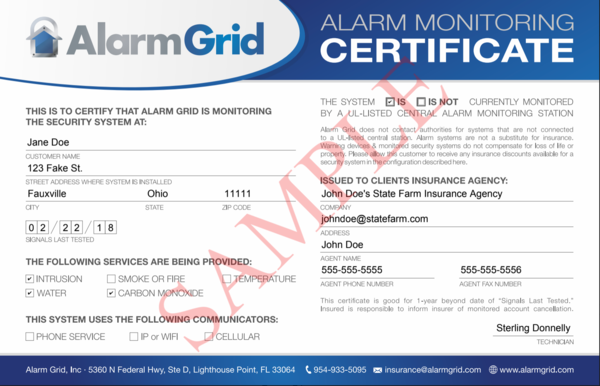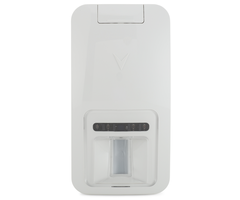A Realistic Look at How Alarm Systems Save You Money
Posted By Michael GorisWe have discussed many times before how a Certificate of Alarm (CoA) can save you money in homeowner's insurance. Today, I want to talk about my personal experience in this aspect and explain how my security system literally pays for itself. This is a huge benefit of owning an alarm system.
 As I mentioned before, I became a first-time homeowner earlier this year. Like many homeowners with a mortgage, my loan requires me to maintain active homeowner's insurance. This meant that I had to obtain homeowner's insurance for the first time ever. Installing an alarm system and activating it for monitoring service is one way that I was able to reduce my homeowner's insurance premium. As someone with specific knowledge of the security industry, setting up an alarm system was one of my first priorities when moving into my home.
As I mentioned before, I became a first-time homeowner earlier this year. Like many homeowners with a mortgage, my loan requires me to maintain active homeowner's insurance. This meant that I had to obtain homeowner's insurance for the first time ever. Installing an alarm system and activating it for monitoring service is one way that I was able to reduce my homeowner's insurance premium. As someone with specific knowledge of the security industry, setting up an alarm system was one of my first priorities when moving into my home.
Prior to my home purchase, I had heard first-hand accounts of how an alarm system can fully pay for itself thanks to savings in homeowner's insurance. But to see it for myself in my own personal practice is really something incredible. I'm realistic, and I wouldn't call these savings anything life-changing. But I can say with complete honesty that there is absolutely no reason for anyone in a similar situation as me not to purchase an alarm system and get it monitored. Not only am I essentially operating an alarm system for free, I actually have a net gain in the overall equation.
In my personal experience operating a monitored security system in South Florida, my savings in homeowner's insurance is approximately $320 annually. This equates to a little bit less than 10% of my total homeowner's insurance premium. Since I have a Honeywell Lyric Security System on IP-only with a monitoring plan that includes central station service and access to Total Connect 2.0 (the Alarm Grid Silver Plan), my monitoring expenses equate to $25 per month, or $300 annually. This results in a net gain of $20 annually. This $20 net gain itself isn't anything to write home about, but the fact of the matter is that I am receiving top-of-the-line monitoring service and protection for my home at no cost to me. You could even argue that I'm being paid to have a security system in my home!
For reference, my homeowner's insurance provider is Citizens. The $320 in savings just represents what Citizens offered to me based on the cost of my home, its location, and the type of monitoring coverage listed in my CoA. I cannot promise that Citizens, or any other insurance provider for that matter, will offer similar savings on your personal policy. Your savings may absolutely vary, and you will need to check with your insurance provider to see what you can qualify for. We have heard of cases where an insurance provider may not offer any savings for maintaining a monitored alarm system, so keep that in mind.

To provide a bit more detail, my savings offered from Citizens come from having a system that is certified for burglary/intrusion monitoring and fire monitoring, with central station service. Citizens only requested proof that my system is actively monitored with central station service, and they did not ask which communication path my system was using (Phone Service, IP/WIFI, and/or Cellular). They also did not provide any indication to me that I would receive increased savings by upgrading to a cellular communicator. Upgrading to cellular is something that I plan to do in the near future, as I know the benefits. I know that making the upgrade will increase the cost of my monitoring service to $420 annually and put me at a net negative in terms of savings, But that is a personal choice that I will make in the interest of protecting my home.
Again, I need to stress that my savings are unique to me. A different insurance provider, or even the same insurance provider in Citizens, might offer you savings that are completely different from mine. That remains true even if you bought a home of identical value as mine in the same zip code. I am not trained in actuarial sciences, and I do not know the process Citizens used for determining my savings. Additionally, your insurance provider may require you to receive monitoring service through a cellular communication path. The only thing I can do is report on what Citizens offered for me personally. Your experience may be completely different. Really, you should be prepared to not receive any savings from your insurance provider. Just consider any offered savings to be a nice bonus to having a security system.
Just like anyone with a proper CoA, I am required to test my system annually. Alarm Grid must receive proof at least once per year that my system is capable of transmitting alarm signals to the central monitoring station. This is required by law, and I am not treated any differently as an Alarm Grid employee. But testing my system once per year to have it fully pay for itself is completely worth it, in my opinion. I would say that the biggest obstacle to any homeowner looking to get started with a CoA and homeowner's insurance savings would be the upfront cost of actually buying a security system and the associated hardware. You can absolutely shop around and possibly buy a used system elsewhere to minimize costs. Just remember that we cannot vouch for the quality or performance of any system not sold by Alarm Grid. Anyone who does decide to purchase a used security system and/or communicator should make sure that the equipment is capable of being used for alarm monitoring service.

Remember that obtaining a legitimate CoA and receiving a discount in your homeowner's insurance does not necessarily entail using your security system. All we need to see is proof that your security system is able to successfully transmit alarm signals for whatever types of alarms are to be listed in your CoA (Intrusion, Smoke/Fire, Carbon Monoxide, Water/Flood, and Temperature). While we certainly encourage you to use your system as intended, we aren't here to monitor or report on its usage. If you have no intention of using your system, and you are just getting it for the insurance discount, then you don't need to let us know that, but we won't be any wiser. Just make sure to keep up with your monthly payments and perform a CoA test annually so that the certification stays legitimate.
If you want to get started with a security system so that you can save money in homeowner's insurance, please email us at support@alarmgrid.com. We will be happy to work with you and help you determine the ideal monitoring plan for your needs. We check our email from 9am to 8pm ET M-F. You may also want to reach out to your insurance provider to learn more about what savings are available to you. Remember, your savings may vary drastically, and only your insurance provider can give you an accurate estimate or quote. But we'll be here to work with you once you're ready to get started. We look forward to hearing from you!













 Nortek is arguably best-known for 2GIG, which focuses mostly on the security industry. This is, of course, the manufacturer of the popular
Nortek is arguably best-known for 2GIG, which focuses mostly on the security industry. This is, of course, the manufacturer of the popular